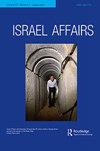Introduction
IF 0.6
4区 社会学
Q3 AREA STUDIES
引用次数: 0
Abstract
Multiaxial fatigue is a subject of concern to both engineers and research scientists. In the eventuality of failure, fatigue lifetime is determined in the majority of cases by the applied multiaxial stress-strain state, whether generated by multiple loading or the component geometry itself. Thus multiaxial stresses should be taken into consideration by the designer, and it is important to note that material data generated in laboratories under constrained situations (for example, uniaxial loading or Mode I crack growth specimens) cannot be used in practice without recourse to some multiaxial criterion. The introduction of stresses on two or three axes in fatigue experiments, therefore, can provide valuable insight concerning both the micromechanisms of fatigue crack formation and growth and also the uses and limitation of multiaxial correlation factors. The multiaxial behavior of metals has been studied throughout the twentieth century, and the engineers concern with the fatigue limit in the design of safe structures has led to a number of useful criteria which were developed prior to 1960, based on, for example, the pioneering work of Gough and Sines. Two more recent developments associated with the finite life of structures are fracture mechanics and life prediction techniques for high-strain fatigue, both of which have required the development of additional criteria. In these cases a knowledge of the extent of plastic deformation is important since inelastic strains are used not only in low cycle fatigue analyses but also in advanced elastic-plastic fracture mechanics. However, a number of problems remain to be solved, since fatigue cracks are invariably associated with notches or surface defects, and frequently experience aggressive environments. This volume presents a number of papers which were read at the International Symposium on Biaxial/Multiaxial Fatigue, sponsored by the American Society for Testing and Materials in collaboration with the American Society of Mechanical Engineers, the American Society for Metals and the Society of Automotive Engineers. The need for a conference was recognized in 1979 after preliminary discussions in Sheffield between the editors and European friends, but, because much new work in multiaxial fatigue had been funded by the Nuclear Regulatory Commission in Washington, it was thought proper to approach ASTM to see if they would sponsor the event in the USA. First contacts were made at the Bal Harbour meeting in Florida in 1980 via such people as Jane Wheeler and Don Mowbray. The three day meeting, held in San Francisco in December 1982, led to many stimulating discussions among the delegates from several介绍
多轴疲劳是工程师和研究科学家共同关心的问题。在可能发生故障的情况下,疲劳寿命在大多数情况下由施加的多轴应力-应变状态决定,无论是由多重载荷还是部件几何形状本身产生。因此,设计者应考虑多轴应力,重要的是要注意,在实验室中在受约束的情况下(例如,单轴加载或I型裂纹扩展试样)生成的材料数据在实践中无法使用,而不采用某些多轴标准。因此,在疲劳实验中引入两个或三个轴上的应力,可以对疲劳裂纹形成和扩展的微观机制以及多轴相关因子的用途和局限性提供有价值的见解。整个二十世纪都在研究金属的多轴行为,工程师们在安全结构设计中对疲劳极限的关注导致了许多有用的标准,这些标准是在1960年之前制定的,例如基于Gough和Sines的开创性工作。与结构有限寿命相关的两个最新发展是高应变疲劳的断裂力学和寿命预测技术,这两项技术都需要制定额外的标准。在这些情况下,塑性变形程度的知识是重要的,因为非弹性应变不仅用于低周疲劳分析,而且用于高级弹塑性断裂力学。然而,许多问题仍有待解决,因为疲劳裂纹总是与缺口或表面缺陷有关,并且经常经历侵蚀性环境。本卷介绍了在美国测试与材料学会与美国机械工程师学会、美国金属学会和汽车工程师学会合作主办的双轴/多轴疲劳国际研讨会上阅读的一些论文。1979年,编辑们和欧洲朋友们在谢菲尔德进行了初步讨论后,认识到了召开会议的必要性,但由于华盛顿核管理委员会资助了许多关于多轴疲劳的新工作,因此人们认为应该联系ASTM,看看他们是否会在美国赞助这项活动。第一次接触是在1980年佛罗里达州巴尔港会议上通过简·惠勒和唐·莫布雷等人进行的。1982年12月在旧金山举行了为期三天的会议,来自几个国家的代表进行了许多令人兴奋的讨论
本文章由计算机程序翻译,如有差异,请以英文原文为准。
求助全文
约1分钟内获得全文
求助全文
来源期刊

Israel Affairs
AREA STUDIES-
CiteScore
0.70
自引率
25.00%
发文量
65
期刊介绍:
Whether your major interest is Israeli history or politics, literature or art, strategic affairs or economics, the Arab-Israeli conflict or Israel-diaspora relations, you will find articles and reviews that are incisive and contain even-handed analysis of the country and its problems in every issue of Israel Affairs, an international multidisciplinary journal. Scholarly and authoritative, yet straightforward and accessible, Israel Affairs aims to serve as a means of communication between the various communities interested in Israel: academics, policy-makers, practitioners, journalists and the informed public.
 求助内容:
求助内容: 应助结果提醒方式:
应助结果提醒方式:


